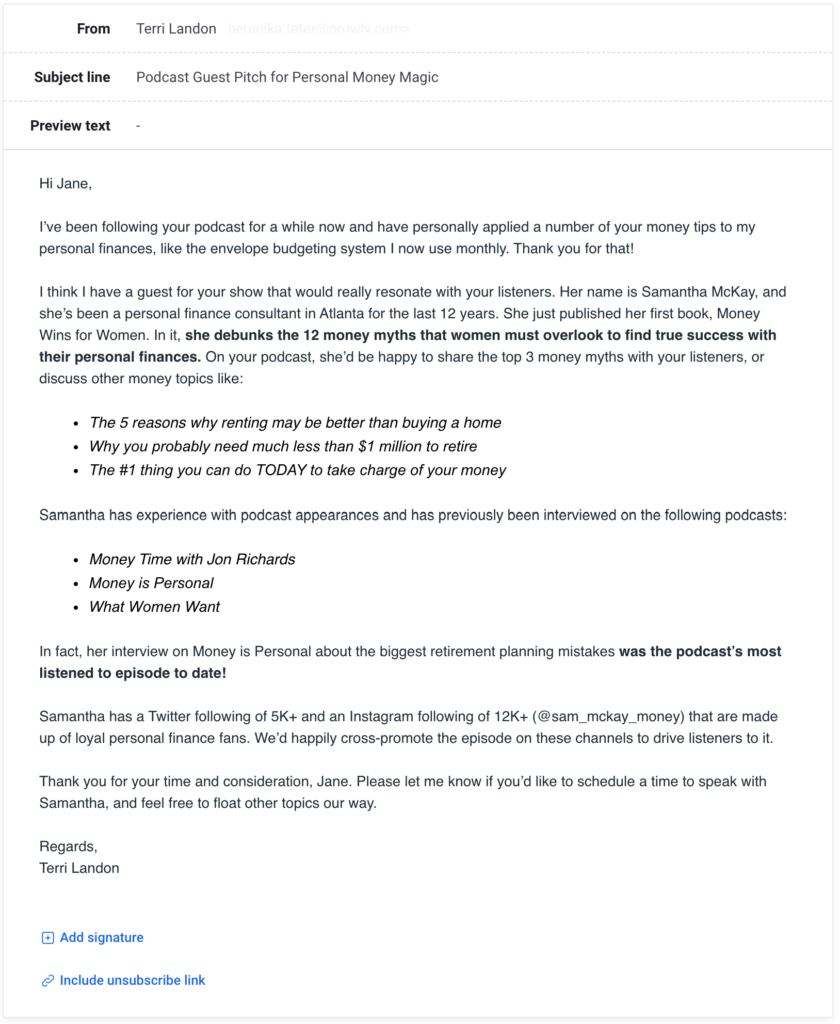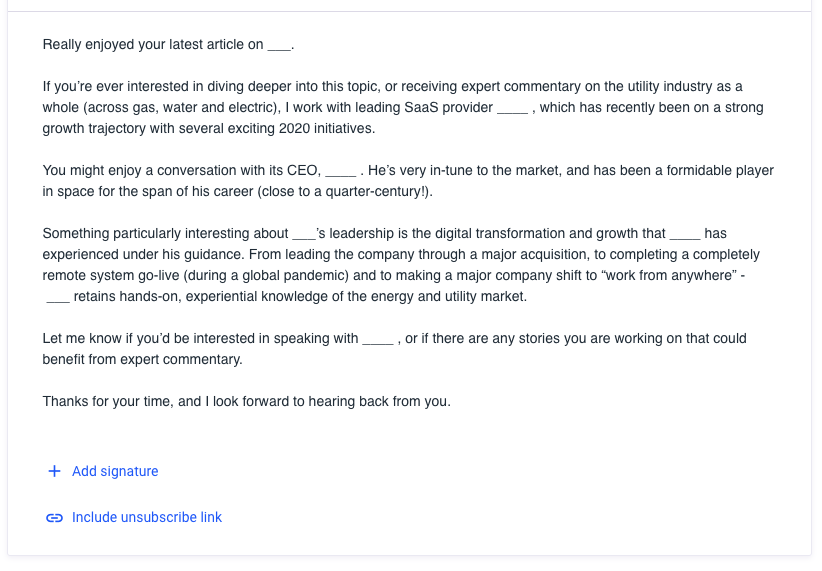The times we live in create an impression that you’re able to reach nearly everyone on planet Earth without leaving your home. While that’s true in most cases, contacting specific people can be an issue, even if we live in a digital age.
Hollywood movies and various television shows shaped the perception we have of journalists - frantically running around looking for the best latest news and stories, investigating mysteries, and covering the latest media crisis. Although these scenarios are not far from the truth, the majority of their work is much more trivial than that.
Journalists don’t have easy jobs and if they’re a big name in the industry and have a large social media following, it becomes more and more difficult for them to sort through worthy and unworthy pitches. Of course, brands like Apple and Tesla don’t have an issue getting in the press, but unless you are them, chances are you will need to bend over backward to get someone’s attention with your pitch.
During the last ten years, I have worked for several lifestyle media titles. Over that period of time, I’d be lying if I said I didn’t get more than tens of thousands of pitches from PR specialists. Everything from mediocre pitches, to award-worthy ones, ones I didn’t even click, and those I still think about.
Here are a few of my personal tips on how to pitch a story and maximize your chances of getting coverage, along with insights from fellow journalists:
How to pitch a story to journalists
Personalize your pitch
One of the biggest mistakes when writing a pitch is sending a mass email with a few words. Even if your pitch sounds seemingly personalized, I can spot a mass email from a mile away.
Some of the worst pitches I received over the years started with something like “Latest news…” and then followed with “Hi, I’m sending you a press release in the attachment”. That’s it and nothing more.
Personalizing your pitch is not only limited to putting your recipient’s name in the headline.
Always remember who you are writing to. There is no point in sending the same information to a large group of recipients. Most will not read them. If you have a topic of interest to a particular journalist, write a personalized message directly. - Łukasz Załuski, Head of Digital @ National Geographic Poland
If you want to personalize your pitch, find out your recipient’s interests, latest publications, or something special about them. Most journalists have a very narrow area of expertise.
This is the worst sin of all – not knowing your addressee, both the outlet and the work and interests of the particular journalist you are sending the press release to. This causes you to send out exactly the same thing in bulk, which results not only in a bad image for the brand, but most of all for the PR agency which employs such a thoughtless method of trying to get their client in the media. - Paweł Zieleniewski, Editor-in-Chief @ Forbes
For example, an automotive journalist that specializes in off-road and brands like Jeep or Land Rover won’t be interested in the newest Ferrari model. Yes, both have four wheels but one does not equal the other. At least not in the case of scoring with your pitch.

Be specific and straight to the point
But isn’t a compelling story the best thing to do? Well yes, and no. Journalists receive dozens of emails weekly, or even daily, and don’t have the time to look for a hidden message within your pitch. What you want to do is give them exact details.
From my personal experience, if you want to know how to pitch a story to a journalist and get your pitch noticed, remember this one thing - don’t waste their time. Inexperienced PR specialists try to get our attention by writing emails with clickbait headlines, e.g. “You won’t believe that” and trust me, it doesn’t work.
Luckily, this happens less and less often but it’s still worth mentioning. We know about clickbait more than you can imagine and if you do use it, journalists know you probably don’t have much to say.
Do your homework. Be brief and to the point. Tell the writer WHY the news in the release is important to his/her readers, and do so as soon as you can. Don’t make the journalist search through your whole press release to find the answer to this vital question. Make things as simple as possible for the journalist by providing useful links and graphics and easy ways to contact the press release writer. - Seth Arenstein, Editor @ PR NEWS
Just because you need to be specific, doesn’t mean you need to write a few lines of text. What you do want to do is, however, avoid using too many adjectives and buzzwords such as “groundbreaking”, “innovative”, “phenomenal” etc. These are filler words and if you have something worthy to tell me, you don’t need to use those. A good pitch should have all the information a journalist needs to know within the first two or three sentences. It’s a good rule of thumb to use.
Additionally, don’t be afraid of visual elements, graphics, videos, and anything to get your point across in the most effective and easiest way possible.
I find links to video materials and visual attachments helpful. Sometimes pitches come without graphics, so I need to look for them on my own to publish the story at all. I also value links to previous pitches if they contain information on similar topics. It helps broaden the context of the written article. - Roger Żochowski, Editor-in-Chief @ PSX Extreme and PPE.pl
Offer something valuable
All PR specialists hope that sending out pitches will result in some kind of publication, but what they do need to remember is that this should be a symbiotic relationship. A journalist will not publish your story if there is nothing in there of value.
News that your boss comes to my town or you take some actions on the other end of the world does not make a good story for me. I may treat the pitches that help ME achieve my goals, like SEO positioning, as a bonus, and take them into consideration. - Mateusz Żuchowski, Automotive Magazine Contributor @ autokult.pl
Let’s assume you want to spread awareness about a shopping mobile application. In that case, you can:
1. Offer a possibility to interview the CEO of the company or an expert in the field with relevant information about the industry. That way, journalists will have an opportunity to receive more specific information about the said company and learn more about the product.
2. Carry out a survey about shopping habits and refer to the results in your pitch. Journalists, readers, and your next-door neighbor all love numbers. Plus, they make articles look more professional and trustworthy.
3. Attach an infographic or other visuals. It will make your pitch more convincing and give you higher chances of getting published.
Sending an email pitch to a journalist doesn’t have to be nerve-racking and give you anxiety. Ultimately, you simply need to give more than just blank lines of text.

Don’t forget to follow up… but wait
First, all you hear about is following up, right? True, it’s a crucial step in the pitching process. But one of my pet peeves is PR specialists who are too eager to get an answer to their pitch. I do understand the impatience, but don’t follow up the same day or the next day.
It’s literally the second-worst thing you can do after calling the journalist directly with questions like “When will the story be published?”, “Are you publishing my story yet?”. Give it time.
The best moment to follow up on your pitch is to send it about 2-3 days after your first one. Once they do answer, make sure you’re replying in a timely manner and your responses are well-written.
I don’t like when one company sends me tons of emails, even 3-4 per day. PR specialists shouldn’t make a rookie mistake that is forgetting to hide the whole list of recipients. And, last but not least – if someone assures me that he will be happy to answer my questions, he should reply to my emails and answer my calls” - Roger Żochowski, Editor-in-Chief @ PSX Extreme and PPE.pl
Ready to pitch your story to a journalist?
Although this guide is based on my own personal experience, I can guarantee you that most, if not all journalists go through the same hassle when searching for the best pitches in the mailboxes. Knowing how to pitch a story to a journalist doesn’t need to be difficult if you follow these guidelines as much as you can.
In short, make your pitch personalized and recognize the interests or expertise of the journalist you are pitching to. Be specific about what you’re writing and don’t go off into different tangents. Then, make your pitch valuable and provide something the journalist can give as a benefit to his or her readers. Last, follow up, but give it time. That’s all it takes to increase your chances of getting your story published.
When you're ready to pitch, give Prowly PR software a try to get media contact recommendations, know who opened your emails or read press releases, follow up accordingly, and more.
Cover photo by Jon Tyson

